Victoria Falls, one of the world’s largest sheets of continuously falling water, is one of Africa’s most well known attractions. The Zambezi River plummets over the falls between Zambia and Zimbabwe to the tune of 500 million liters of water per minute during the wet season.1 The great debate is whether the falls are best viewed from Zambia or Zimbabwe – we visited both sides for maximum consideration.
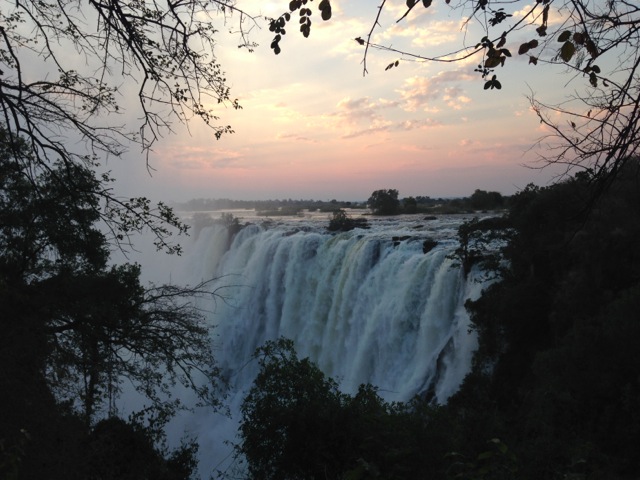
Livingstone, Zambia
Our 23-day camping adventure with Wild Dog Safaris concluded in Livingstone, Zambia. To reach Livingstone, we first had to get from Botswana into Zambia, a journey that required an early morning ferry crossing of the Zambezi River. Interestingly, Botswana and Zambia have the distinction of sharing one of the world’s shortest international borders – covering a mere 750-meter stretch of the river. From where we stood to board the ferry, we could see Botswana, Zambia, Namibia, and Zimbabwe.
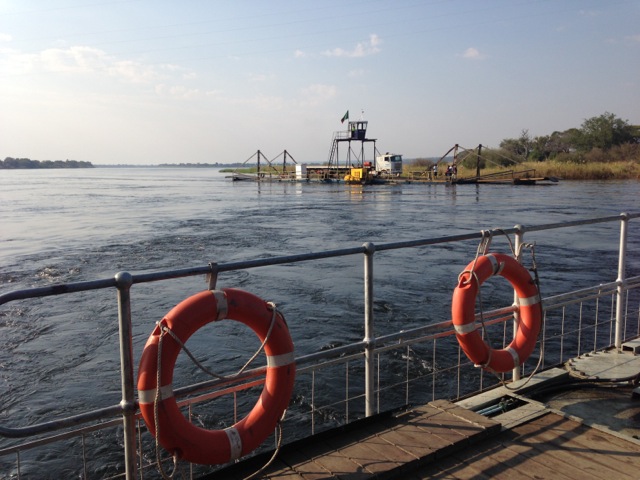
Our guide had warned us that it might take up to three hours to get our vehicle and ourselves through the immigration/customs gauntlet on the Zambian side, but Lady Luck was smiling on us and the whole process – including purchasing our visas – took only about an hour. Although we were then stopped at various checkpoints on our way to Livingstone (including one spot that demanded a $10 per person “park fee” just to use a laughably short section of the access road leading to our lodge2), we made it to our campsite by late morning.
After setting up camp and eating our last lunch of polony-and-shredded-cheese sandwiches, we set out for the Zambian side of the falls, located in Mosi-oa-Tunya National Park.3 Victoria Falls is rumored to be a highlight of any trip to Southern Africa, and as we had seen the mist rising from the falls from miles away as we approached Livingstone and could hear the falls’ dull thundering roar from our lodge, we were all good and ready to finally see them by this point.
Our visit in early June was not long after peak wet season, and the quantity of water thundering over the falls resulted in a mist that almost completely obscured them at times. In some ways, this made the visit more magical: there you were, suited up in your poncho, meandering along a path through what felt like a driving rain, when, suddenly, the air would clear and the falls would seem to materialize right before you.
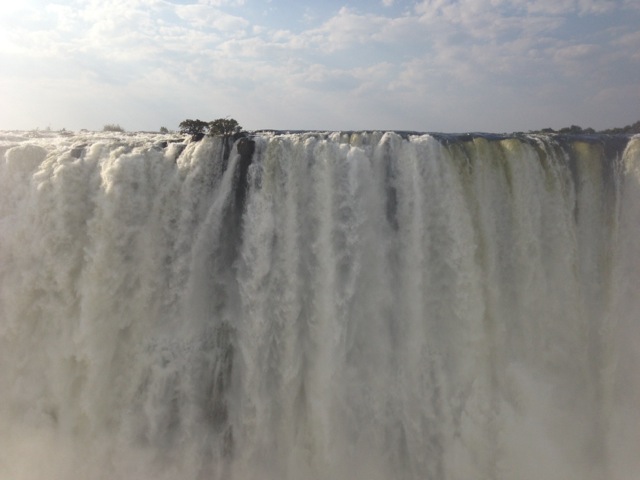
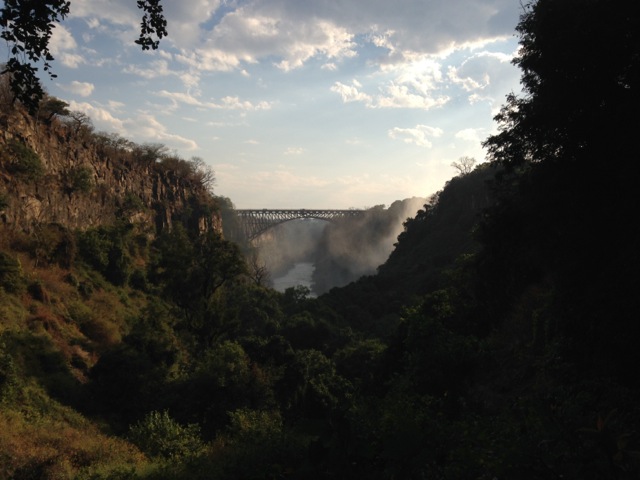
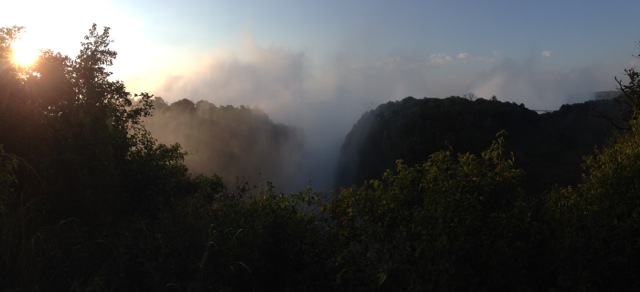
We sampled a couple of paths: the Knife Edge, which felt a bit daring at times as the stone path was wet and slippery and you would be hit with sheets of water crossing the footbridge; the “Best Photographing Trail,” which viewed the falls more from above and, because of the mist, didn’t provide the best view at that time of year; and the path down to the Boiling Pot, which descended from the brown foliage that is otherwise characteristic of the dry season in this part of Africa, through jungle-like lushness in the rainforest microclimate that forms near the falls, to the base of the falls, where the water swirled impressively before exiting through a series of deep gorges.
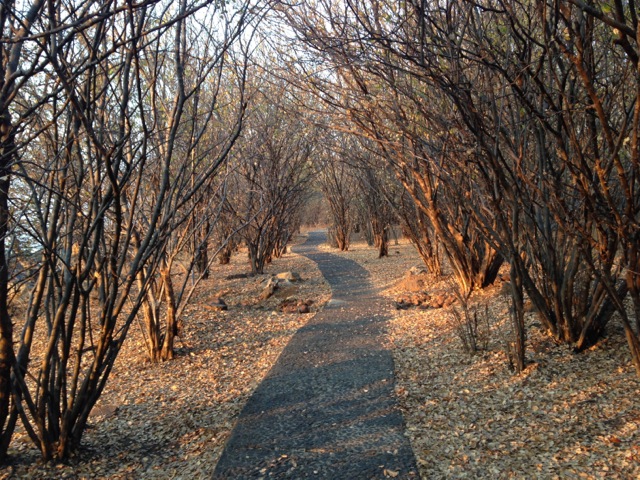
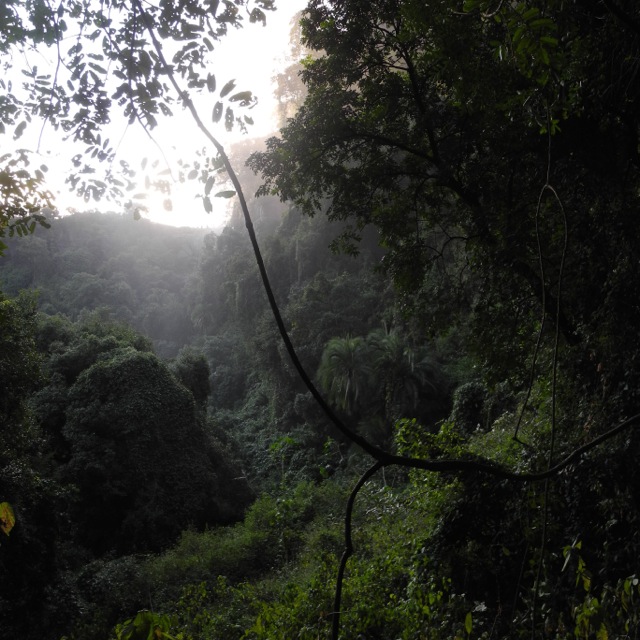
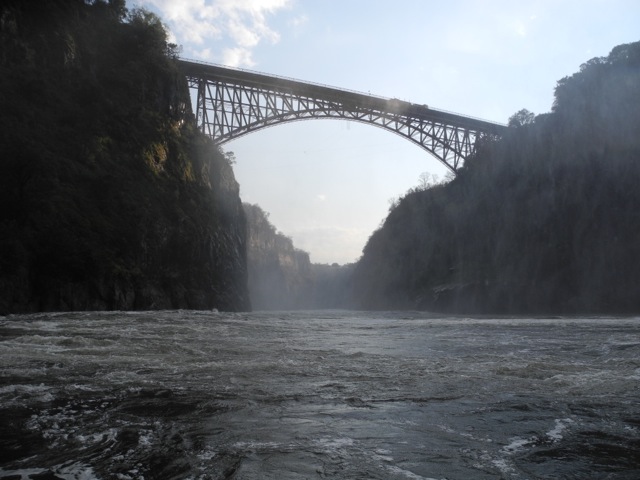
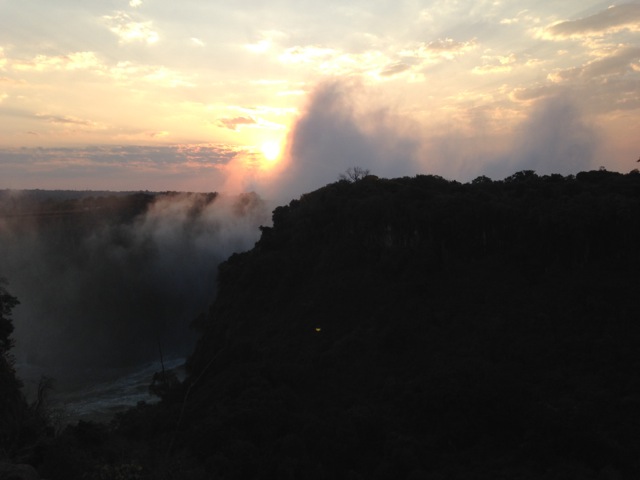
Like in the Garden Route and Swakopmund, the Livingstone tourism industry urges you to partake in various adventure “activities.” Our second day in Livingstone was styled as a free day so that we could indulge in the activities of our choice: bungee jumping, zip-lining, helicopter rides. After seeing the eye-popping prices of some of the things on offer – over $300 per person for a 15-minute helicopter ride – Marc and I decided to eschew the activities and laid low, enjoying our first day without travel in over three weeks. He ventured into town with another member of our group who needed to secure her yellow fever vaccination,4 and I stationed myself at our hotel on a beach chair in the sun and worked on blog posts. (The things I do for you people!) Some members of our group took the helicopter ride, and showed us the pictures; it was an amazing view.
After breakfast the following morning, the members of our camping safari went their separate ways: some were staying on in Livingstone, some were heading back to Windhoek, and we got a lift to the border to walk across the Victoria Falls Bridge.
There’s something a little surreal about walking across that bridge. Constructed just after the turn of the last century, the Victoria Falls Bridge is an attractive bridge still in use for vehicle, rail, and foot traffic. Heavy cargo trucks transit over the bridge, crossing between Zambia and Zimbabwe, rumbling past the breath-taking view of Victoria Falls. We lumbered over, heavily laden with our large packs and daypacks. As we paused to take a few pictures in the middle of the bridge, the guy manning the bungee jump called out to us and invited us over to take a look at the operation. It made me knees shake, but it was a beautiful view.
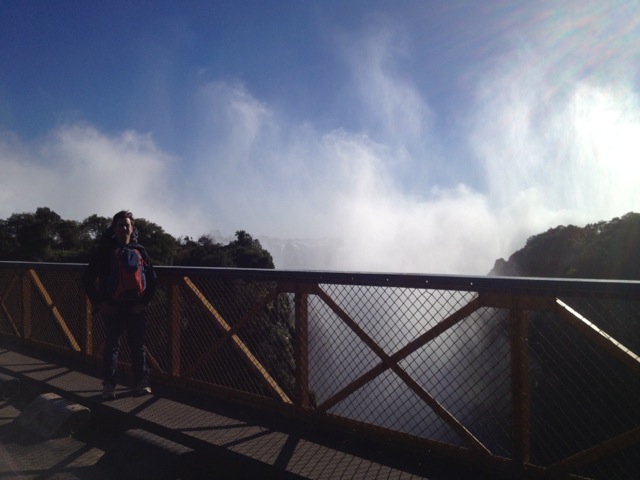
Victoria Falls, Zimbabwe
On the other side of the river, Victoria Falls, Zimbabwe is much more of a tourists’ town than Livingstone.5 You can debate amongst yourselves whether that is a positive or negative attribute, but it suited our tent-weary selves just fine. We rented ourselves a small chalet (four walls! actual beds!), indulged in some laundry service (clean socks!), and proceeded to while away several hours drinking real (not instant!) coffee on a nice couch at the Africa Cafe.
After a good night’s sleep, we set out for the Zimbabwean side of the falls, at Victoria Falls National Park. All reports indicated the falls themselves were more visible from the Zimbabwean side, and we found that to be true. The park identified several viewpoints, and a good number of them offered amazing vantages of the falls. Some of the viewpoints were, like on the Zambian side, completely obscured by the mist, and we once again got completely drenched. To answer the million-dollar question: I preferred the Zimbabwean side of the falls – but, had we come during a different time of year when the viewing was better on the Zambian side, I might have had a different answer.
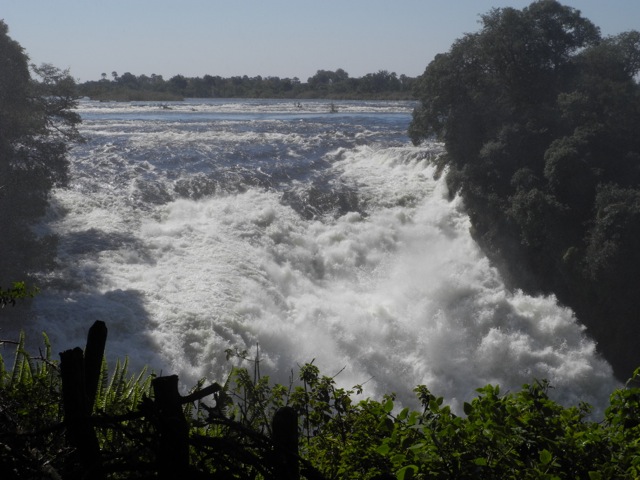
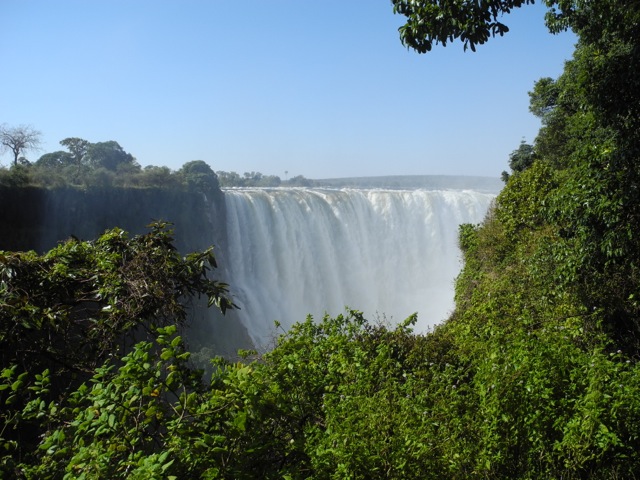
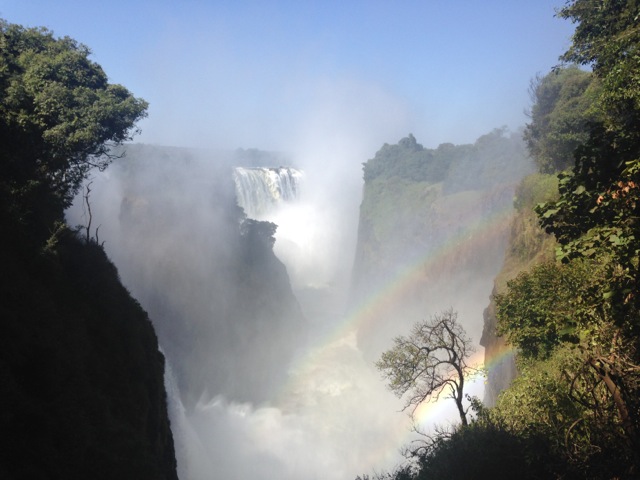
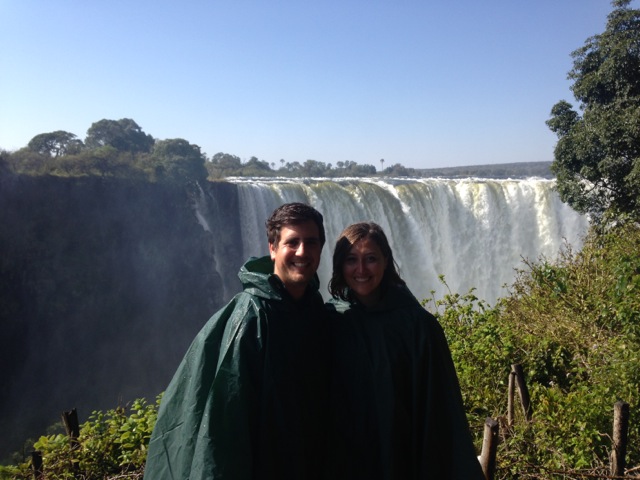

Arguably the best place to admire the falls outside of the two national parks is from the lawn of the Victoria Falls Hotel. You don’t have to be a guest at the historic hotel to gawk at the falls from the lawn, but a fun thing to do is take high tea on the hotel’s terrace. While sipping tea and selecting between tea sandwiches and finger cakes, you can watch as other tourists with questionable judgment fling themselves from the Victoria Falls Bridge attached to a mere elastic band. (Pro tip: Use the lotion in the Victoria Falls Hotel bathroom; it’s amazing. I couldn’t stop smelling my arms for the rest of the day.)
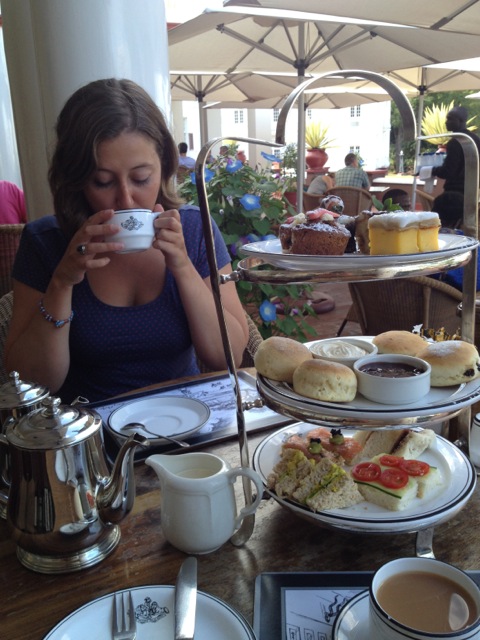
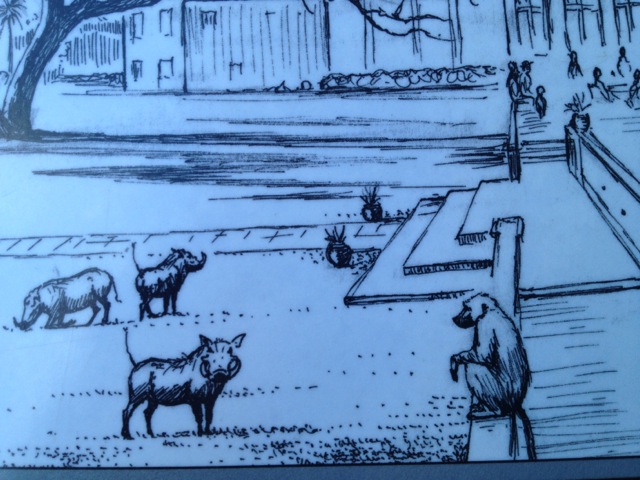
Where We Stayed:
☆ Zambezi Waterfront Lodge. Three goats. The riverfront area along the Zambezi was nice, but the restaurant and sitting area is not enclosed. It would have been lovely during a warmer time of the year, but in June it was too cold.
☆ Victoria Falls Restcamp and Lodge. Two-and-a-half goats. This place is totally functional, but it’s definitely no frills. I’m subtracting half a goat because I tripped over the sidewalk on my walk back from the shower and skinned my knee; feel free to add that goat back in if you don’t think the place should get a demerit for my clumsiness.
Where We Ate:
☆ Zambezi Waterfront Lodge, Livingstone, Zambia. Because the hotel was several kilometers outside of the center of town, we ate dinner here while in Livingstone. The pizza was pretty good, and the vegetable wrap was surprisingly tasty.
☆ In Da Belly, Victoria Falls, Zimbabwe. This was the restaurant at Victoria Falls Restcamp and Lodge; we ate here several times out of convenience. Dinner was hit or miss: I enjoyed the vegetable pasta, but Marc’s curry came in an absurdly small portion.
☆ Africa Cafe, Victoria Falls, Zimbabwe. The world’s best veggie burger is on offer here. It’s a succulent mushroom burger topped with feta cheese, tomato jam, and onion rings, and it is to die for. Also, it’s a great place to sit and drink real coffee. We even spotted all the Miss Zimbabwe finalists (in their sashes and towering 5-inch heels) enjoying lunch here!
1 During the dry season, this flow is dramatically reduced to 10 million liters per minute – only two percent of falls’ wet season output.
2 Apparently the lodge was set within the boundary’s of Mosi-oa-Tunya National Park, but had only recently began charging guests a fee to nominally enter its grounds. The park fee only earned its keep on our last day in Livingstone. In the late afternoon, Marc and I were sitting near around our campsite when we heard a lot of commotion. We looked up and saw a group of elephants traipsing by on the other side of the fence. The elephants were so close; it was awesome to watch them come through, grabbing branches and eating them as they walked. Prior to those elephants, we had only seen some monkeys, which were not only less exotic but common thieves: one of them absconded with half of Marc’s grapefruit.
3 Roughly translated, this indigenous name for Victoria Falls means “the smoke that thunders.”
4 Important travel reminder: If you are going to Africa, double-check whether you will need a yellow fever vaccination for the countries you are visiting. You may need a vaccination certificate even if you are just transiting through another country. (For example, if you have been in Zambia and have a connecting flight back home through Johannesburg, you may need to show the certificate as you transit through the airport.)
5 Historically, Zimbabwe had been the principal country that most foreign visitors had come to when viewing the falls, and thus the town of Victoria Falls, Zimbabwe, situated right next to the falls, developed around the tourism industry. The financial collapse and period of hyperinflation that Zimbabwe suffered several years ago, however, drove nearly all of the tourism across the border into Livingstone, Zambia – a city that, unlike its Zimbabwean counterpart, is set back several kilometers from the falls and only recently had become a tourism center. As Zimbabwe’s economic situation begun to stabilize in recent years, tourism has once again returned.

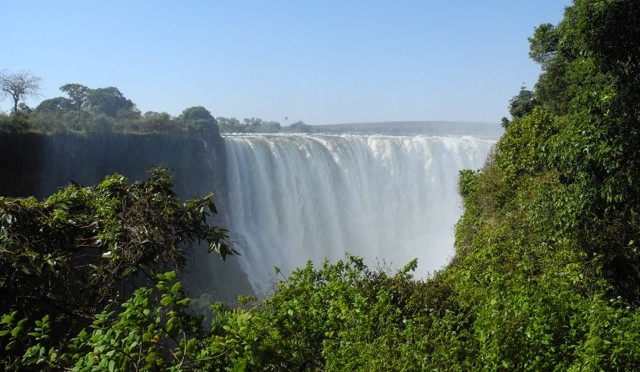

Spectacular pictures and soooo much useful information! One question, though: What type of shoes would you recommend for those wet and slippery paths? (I’ve got three choices.)
Do you have an active sandal among your choices? I wore my Chaco’s, and I found them ideal for Victoria Falls because they were sturdy enough to handle the wet stones but open enough that they didn’t become waterlogged. Other members of our group wore sneakers, which worked well enough although the sneakers later needed to be aired out. Marc wore flip-flops, and he fared well, but I wouldn’t recommend it. I would definitely go with an active sandal!
It is such fun to read about your travels. The writing is excellent and the photographs are amazing; they look so professional. I’d love to see a few more photos of you and Marc in the mix! I am missing you guys!
A wonderful and balanced write up on our region. Special thanks from Chef Thomas Mwembe on the great review you gave The Africa Cafe! He and his team were really stoked when they read it. Regards from Vic Falls
We’re glad to hear it! We loved the Africa Cafe and would recommend it to anyone traveling through Victoria Falls.